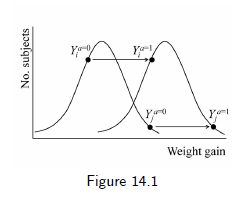G-estimation of structural nested models
What If: Chapter 14
Elena Dudukina
2021-11-10
1 / 13
14.1 The causal question revisited
- generalized methods for treatment contrasts that vary over time
- models whose parameters are estimated via g-estimation are structural nested models
- each g-method has a different set of modeling assumptions
2 / 13
14.1 The causal question revisited
Total effect and no censoring: E[Ya=1,c=0] - E[Ya=0,c=0]
Effect in the stratum: E[Ya=1,c=0|sex=1] - E[Ya=0,c=0|sex=1]
- IPT-weighted MSM with interaction term
- Standardisation in the stratum of interest
- g-estimation
3 / 13
14.1 The causal question revisited
g-estimation to estimate the average causal effect of smoking cessation A on weight gain Y in each strata defined by the covariates L
E[Ya=1,c=0|L] - E[Ya=0,c=0|L]
4 / 13
14.2 Exchangeability revisited
- Conditional exchangeability: the outcome distribution in the treated and the untreated would be the same if both groups had received the same treatment level: Ya⊥⊥A|L for a=0 and a=1
- Knowing the value of Ya=0 does not provide information (help distinguish) between exposure levels: Pr[A=1|Ya=0,L] = Pr[A=1|L]
- logitPr[A=1|Ya=0,L]=α0+α1Ya=0+α2L and so α1=0
5 / 13
14.3 Structural nested mean models
- Assuming no censoring: E[Ya=1|L] - E[Ya=0|L]
- Structural model for the conditional causal effect: E[Ya=1−Ya=0|L] = β1∗a
- Structural model for the conditional causal effect with EMM by L: E[Ya=1−Ya=0|L] = β1∗a+β2∗a∗L
- under conditional exchangeability: E[Ya=1−Ya=0|L,A=a] = β1∗a+β2∗a∗L (structural nested mean model)
- β1 and β2 are estimated using g-estimation
- Nested model means it is "nested" when the treatment is time-varying
6 / 13
14.3 Structural nested mean models
- Structural nested models are semiparametric
- Agnostic about the intercept and the effect of L t(no parameter β0 and no parameter β3)
- Fewer assumptions and potentially more robust to model misspecification than g-computation of the parametric g-formula
7 / 13
14.3 Structural nested mean models
- Assuming censoring: E[Ya=1,c=0|L] - E[Ya=0,c=0|L]
- G-estimation can be used to adjust for confounding but not selection bias
- Need IP weighting for selection bias, first
- Nonstabilized IP weights for construction of pseudo-population:
- $W^C = 1/pr[C=0|L, A
- In pseudo-population without censoring:
- E[Ya=1,c=0|L,A] - E[Ya=0,c=0|L,A]
- = E[Ya=1,c=0−Ya=0,c=0|L,A]
- = β1∗a+β2∗a∗L
8 / 13
14.4 Rank preservation
- Rank each subject according to their observed
Y - Rank according to subjects' counterfactual outcomes Ya
- Had both lists Ya=0 and Ya=1 were in the same, there was rank preservation
- Treatment has no effect on no one's outcome (sharp null hypothesis), the rank preservation holds
- The conditional rank preservation holds when effect of
AonYis the same - Rank preserving structural model: Ya=1i−Ya=1i=ψ1a+ψ2a∗a∗Li with ψ1+ψ2∗l is the causal effect for all individuals i with L=l

- However, the outcomes nearly never are expected to be constant on an individual level and so (additive) rank preservation is implausible.
- Average causal effects are agnostic about the the individual causal effects.
- Never use rank preservation model in practice, however, it is used in the section 14.5
9 / 13
14.5 G-estimation
- Estimate parameters of the structural nested mean model: E[Ya=1−Ya=0|L,A=a] = β1∗a
- No β2∗a∗L term assumes constant treatment effect across strata of L (no additive effect measure modification (EMM) by L)
- Additive rank preservation model assumes that effect of A is constant and the same for all individuals and average causal effect β1 is the same as ψ1 individual causal effect (although implausible in real life)
- Rank preserving model Ya=1i−Ya=0i=ψ1a or Ya=0=Ya=1i−ψ1a
10 / 13
14.5 G-estimation
- 1st step: linking the model and the observed data
- By consistency: Ya=1=Y among A=1 and Ya=0=Y among A=0
- Under rank preservation and correctly specified model: Ya=0=Ya=1i−ψ1a is Ya=0=Y−ψ1A
- ψ1 is unknown and the aim of the analysis is to estimate ψ1
- To compute ψ1 make guesses: 1) -20 2) 0 3) 10
- Then compute: H(ψ∗)=Y−ψ∗A
- If conditional exchangeability holds: α1=0 in the logistic regression model for treatment:
- logitPr[A=1|H(ψ∗),L]=α0+α1Hψ∗+α2∗L
- The guess that gets us closer to α1=0 is the most correct guess
- 95% CI for ψ∗ is computed based on a set of guesses that are tested against the H0 and results with P-values > 0.05 are the limits that form 95% CI
11 / 13
14.6 Structural nested models with two or more parameters
- In the presence of the EMM, the model in the previous slides was misspecified and the answer given was incorrect
- The EMM by V requires estimation of the term β∗a∗V: E[Ya=1−Ya=0|L,A=a] = β1∗a+β∗a∗V corresponding to the rank preserving model Ya=1i−Ya=0i=ψ1a+ψ2∗a∗Vi
- The logistic model for treatment them will be: logitPr[A=1|H(ψ∗,L)=α0+α1H(ψ∗)+α2H(ψ∗)V+α3L], where H(ψ∗)=(ψ∗1,ψ∗2)
- The values of ψ∗1 and ψ∗2 produce H0(ψ∗)⊥⊥A|L, or we need to find guesses that result in α1 and α2 both being zero.
12 / 13
References
- Hernán MA, Robins JM (2020). Causal Inference: What If. Boca Raton: Chapman & Hall/CRC (v. 30mar21)
- https://remlapmot.github.io/cibookex-r/g-estimation-of-structural-nested-models.html
13 / 13